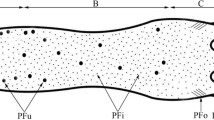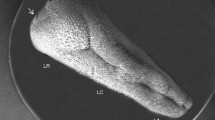Summary
The distribution of lanthanum on the taste disc of the frog,Rana esculenta, afteren bloc staining of the tongue with lanthanum nitrate was studied at the ultrastructural level by means of scanning electron microscopy (in the secondary electron mode or in the back scattered electron mode), energy-dispersive X-ray microanalysis, transmission electron microscopy and electron spectroscopic imaging. It was consistently found that lanthanum distribution on the surface of the taste disc is not homogeneous and that the surface of putative receptor cells is in contact with strongly lanthanum-positive material. Calcium co-localizes with lanthanum at that level. These results suggest that different microenvironments exist at the surface of the taste disc and that this could be relevant to the receptor function.
Similar content being viewed by others
References
Bannister, L. (1974) Possible functions of mucous at gustatory and olfactory systems. InTransduction mechanisms in chemoreception (edited byPoynder, T.) pp. 39–49. London: Information Retrieval.
Behnke, O. (1968) Electron microscopic observation on the surface coating of human blood platelets.J. Ultrastruct. Res. 24, 51–62.
Carmignani, M. P., Zaccone, G. &Cannata, F. (1975) Histochemical studies on the tongue of anuran amphibians.Ann. Histochem. 20, 47–65.
Düring, M. &Andres K. H. (1976) The ultrastructure of taste and touch receptors of the frog's taste organ.Cell Tiss. Res. 165, 185–98.
Fujimoto, S. &Yamamoto, K. (1980) Electron microscopy of terminal buds on the barbels of the silurid fish,Corydoras paleatus. Anat. Rec. 197, 133–41.
Getchell T. V. &Getchell, M. L. (1987) Peripheral mechanisms of olfaction: biochemistry and neurophysiology. InNeurophysiology of taste and smell (edited byFinger, T. E. &Silver, W. L.) pp. 91–124. New York: John Wiley.
Graziadei, P. P. D. &De Han, R. S. (1971) The ultrastructure of frog's taste organs.Acta Anat. 80, 563–603.
Kurihara, K., Yoshii, K. &Kashiwayanagi, M. (1986) Transduction mechanisms in chemoreception.Comp. Biochem. Physiol. 85, 1–22.
Nalavade, M. N. &Varute, A. T. (1972) Studies on the mucines of the vertebrate tongue: II. Mucopolysaccharides in cells of taste buds in tongue of tadpoles ofRana tigrina andBufo melanosticus.Acta Histochem. 43, 202–10.
Ottensmeyer, F. P. &Andrew, J. W. (1980) High resolution microanalysis of biological specimens by electron energy loss spectroscopy imaging.J. Ultrastruct. Res. 71, 336–48.
Rapuzzi, G., Gjlberti, G., Vitali, A. &Villa Balduini, A. (1978) La motilita delle ciglia delle papille fungiformi di rana.Boll. Soc. It. Biol. Sper. 54, 1963–8.
Raviola, E. &Osculati, P. (1967) La fine struttura dei recettori gustative della lingua di rana.Rc. Ist. Lomb. Sci. Lett. 101, 599–627.
Reutter, K. (1987) Specialized receptor villi and basal cells within the taste bud of the European silurid fish,Silurus glanis.Ann. N.Y. Acad. Sci. 510, 570–2.
Revel, J. P. &Karnowsky, M. J. (1967) The exagonal array of subunits in intercellular junctions of the mouse heart and liver.J. Cell. Biol. 33, C7-C12.
Richter, H. P., Avenet, P., Mestres, P. &Lindemann, B. (1988) Gustatory receptors and neighbouring cells in the surface layer of an amphibian taste disc:in situ relationship and response to cell isolation.Cell Tiss. Res. 254, 83–96.
Rölich, P. &Pevzner, R. A. (1982) The chemoreceptor surface of the taste organ in the frogRana esculenta.Cell Tiss. Res. 224, 409–20.
Sapelli, P. L., Franceschini, F., Cinti, S. &Osculati, F. (1983) Données ultérieures sur la caractérisation cellulaire de l'épithelium constituant le' disque gustatif' des papilles fungiforms de la langue de grenouille.Bull. Group. int. Rech. sc. Stomat. et Odont. 26, 99–119.
Sbarbati, A., Franceschini, F., Zancanaro, C., Cecchini, T., Ciaroni, S. &Osculati, F. (1988) The fine morphology of the basal cell in the frog's taste organ.J. Submicrosc. Cytol. Pathol. 20, 73–9.
Shaklai, M. &Tavassoli, M. (1982) Lanthanum as an electron microscopic stain.J. Histochem. Cytochem. 12, 1325–30.
Stensaas, L. J. (1971) The fine structure of fungiform papillae and epithelium of the tongue of a South America toadCalyptocephalella Gayi.Am. J. Anat. 131, 443–62.
Witt, M. &Reutter, K. (1988) Lectin histochemistry on mucous substances of the taste buds and adjacent epithelia of different vertebrates.Histochemistry 88, 453–61.
Author information
Authors and Affiliations
Rights and permissions
About this article
Cite this article
Zancanaro, C., Sbarbati, A., Franceschini, F. et al. The chemoreceptor surface of the taste disc in the frog,Rana esculenta. An ultrastructural study with lanthanum nitrate. Histochem J 22, 480–486 (1990). https://doi.org/10.1007/BF01007232
Received:
Revised:
Issue Date:
DOI: https://doi.org/10.1007/BF01007232




